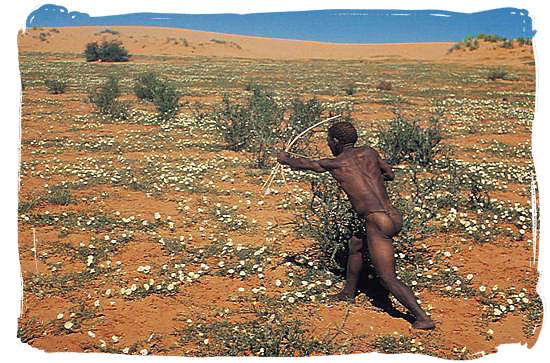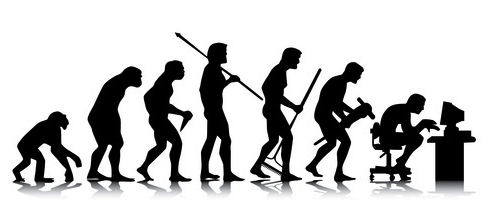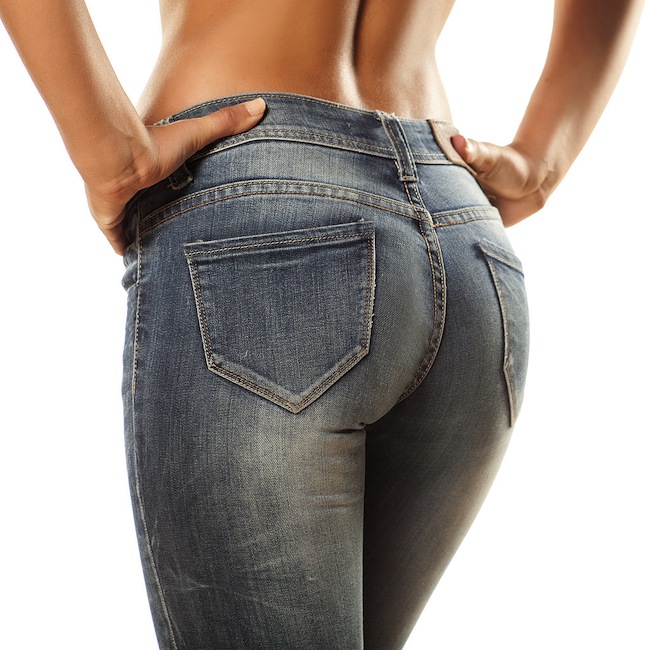By Eirik Garnas
OrganicFitness.com
Big, powerful glutes are great, not just because they make you look good in a tight pair of jeans, but also, as all glute enthusiasts know, because a strong butt sets the stage for safe, heavy lifting in the gym, faster sprints, and a solid and injury-free lower back. The importance of the glutes – and the gluteus maximus (GM) in particular – becomes especially apparent when you work as a personal trainer or coach and see on a day-to-day basis how clients with various levels of glute development perform in the gym. More often than not, those with a strong set of glutes tend to display better movement patterns in the deadlift, squat, and a whole range of other exercises than those with a weak and flabby butt, and they also have lower incidence of back and knee pain. Since the GM is the largest muscle in the human body – and also at the center of the posterior chain – these observations don’t really come as a surprise. But why did the gluteals become such an important muscle group for humans, and why do so many modern people have weak and atrophied glutes? To answer these questions, we’re going to turn back the clock millions of years, to our days as foragers in Africa.

The unique human gluteus maximus
When our ancient ape-like ancestors climbed down from the trees in Africa and began their bipedal journey on the ground, they unknowingly steered the human lineage in on a very different evolutionary path than that of our chimp relatives. The ability to habitually walk on two legs set the stage for further transformations of the hominin body, transformations that made us into who we are today.
If you ask someone what differentiates the human body from that of a chimp, they’ll likely mention our bigger brains, our ability to walk upright, and our bare skin. Some, especially those with an interest in strength training or sports performance, will also highlight the differences in our muscular system, and perhaps most importantly, differences related to the glutes.
Humans are different from the apes in the sense that we lack gluteus maximus ischiofemoralis, the more caudal portion of the muscle, and only have one enlarged gluteus maximus proprius, which is referred to as the gluteus maximus. Since this muscle is the largest of the gluteals by far and has a special role in human evolution, it will be the main emphasis of this article.
In comparison with our chimp relatives, the human GM is approximately 1.6 times larger relative to body mass (1). The patterns of origins and insertions of the human GM are also different from that of the apes, with the human GM attaching higher up to the ilium, the broad, flat upper bone of the hip.
Why did we evolve a big and strong butt?
Why did we evolve differently from other primates? Conclusive data about what happened millions of years ago are clearly hard to come by, but we do have a pretty good idea of why humans evolved a GM that is unique among primates.
It was previously speculated that the growth of the human GM was a necessary prerequisite to the evolution of upright walking, but this theory has later been called into question (2). It only takes very low levels of GM activity to keep the human body stable during walking and standing, meaning that although differences in GM size and patterns of origins and insertions between humans and apes help explain why we are able to stand upright and walk without problems, it’s very unlikely that the evolution of the large GM can be explained simply as a necessary prerequisite to bipedalism.
Rather, studies have shown that the GM is primarily active during climbing, digging, throwing, running, and other activities that require stabilization of the trunk against flexion (1, 3). All of these activities have been proposed as possible explanations for why humans evolved such a large GM, with the endurance running hypothesis – which says that the evolution of certain human characteristics can be explained as adaptations to long distance running– being the most widely held theory.
Humans are poor sprinters compared to quadrupeds, an obvious disadvantage on the African savanna where there was a constant competition between species – or as Charles Darwin would say, “a battle for existence”. Humans aren’t especially strong either, so how did we manage to survive in the wild? Perhaps the most obvious answer that comes to mind is that members of our genus, Homo, evolved larger brains than other primates, and therefore compensated for the lack of brawn by having a superior ability to think and communicate. However, although clearly very useful, a large brain won’t be enough to put dinner on the table, at least in an ancestral natural environment where private transportation, modern weapons, and fast food joints were nowhere to be found. Also, early Homo, which lived approximately 2 million years ago, hadn’t yet fully evolved the massive brains that characterize later members of our genus, and there’s little evidence to suggest that they had “sophisticated” weapons such as spear, bow, and arrow.
Several lines of evidence suggest that a boost in human GM size coincides with our ancient ancestors’ increased reliance on endurance running as a means to get dinner (2, 3, 4). The fossil of Lucy, the girl of the species Australopithecus afarensis who is thought to have lived approximately 3.2 MYA, indicates that she was a walker, but not a runner. She was short-legged and lacked a nuchal ligament, the ligament of the back of the neck that helps keep the head stable during running. With the evolution of Homo approximately 1 million years later, this had started to change, and the data shows that Homo erectus had a nuchal ligament and a big butt, and he was probably a good endurance runner (2, 5).
Several lines of evidence suggest that more animals source food rich in protein and fat was introduced in the hominin diet about 2-3 million years ago (6), something that was largely made possible by the evolution of several traits – including a bigger GM – that improved our ancient ancestors’ ability to hunt and scavenge.
Although there’s some controversy surrounding the endurance running hypothesis, it’s generally accepted that running – perhaps with intermittent periods of fast walking and high intensity – is at least partially what made it possible for our Paleolithic ancestors to put food on the table. This is supported by the following facts:
- It would have been very difficult for hominins to kill large game without being able to hunt and scavenge effectively.
- We are much better long distance runners than other primates and most other animals (5).
- The human body has several traits that are primarily essential for running, not walking (2, 3, 4). These include, but are not limited to, a large GM, springs in the legs that allow energy to be alternatively stored and released when running, the ability to maintain the center of mass stable by rotating the upper body while stabilizing the head and neck when both feet are off the ground, enlarged sensory organs in the ear (the semi-circular canals) to improve the sensitivity of the reflexes that control rapid pitching that occur in running but not walking, a superior ability to thermoregulate when exercising at high-intensity in dry heat, large extensor spine muscles, narrow elongated waist combined with a low, wide, decoupled shoulder griddle that has an essential stabilizing function during running, and short toes. It has been argued that some of these traits could have been adaptations to other activities as well, but in general it’s safe to say that endurance running has played an important role in the evolution of Homo.
Regardless of whether the enlargement and reorganization of the GM primarily were related to running, walking in uneven terrain, climbing, or any of the other aforementioned activities that demand glute activity, it’s clear that a strong gluteus maximus was a trait that provided a survival advantage, and it was therefore selected for through natural selection, the gradual process by which heritable biological traits become either more or less common in a population as a function of the effect of inherited traits on the differential reproductive success of organisms.
Over hundreds of generations, our ancient ancestors evolved bigger and stronger butts, butts that improved the Paleolithic man’s survival in environments where physical activities –such as hunting, digging for tubers, and scavenging for meat – were a natural part of daily life. Besides scaveging, one of the strategies our Paleolithic ancestors probably employed in the search for food was persistence hunting, a hunting strategy in which hunters use a combination of running, walking, and tracking to pursue prey to the point of exhaustion. This strategy favoured members of our genus who have a superior ability to thermoregulate compared to other animals. Persistence hunting is still used by some hunter-gatherer tribes today, such as the !Kung and the Bushmen of Kalahari.

Modern times: Excessive sitting, bad posture, and glute atrophy
Through millions of years of life as hunter-gatherers in the Paleolithic, low fitness variations (i.e., a weak and small GM) were slowly taken out of the population. When the Agricultural Revolution spread across the globe, new physical activity patterns characterized by more farm-related work replaced Paleolithic “exercise routines”. Studies suggest that the physical activity levels of early farmers could have been as high – or perhaps even higher – than that of hunter-gatherers (5), but hunting and scavenging were clearly not as important anymore, a transition that might have led to a decline in the amount of stress placed on the GM.
However, this transition is nothing compared to what has happened over the last centuries, as the industrial revolution has spread the globe, desk jobs have become the new norm, and more and more people spend the majority of their day sitting in a chair. Excessive sitting and sedentary living are bad for a number of reasons, one of which being that the glutes aren’t stressed adequately.
Through millions of years of evolution, the large human GM evolved because it improved our ancestors’ ability to survive in environments where running, walking in uneven terrain, and digging were a demanded part of daily life. When we completely abandon this way of life and adopt a lifestyle which the human body – including the glutes – isn’t adequately adapted for, problems occur.
The portion of our genome that determines basic physiology and anatomy has remained relatively unchanged since the Paleolithic era (5, 6), meaning that although we today wear suits and dresses and drive fancy cars, our Stone Age legacy is still with us. There has been too little time for natural selection to adapt the human body to our new living conditions, and as a result, a discordance between genes and environment has occurred, a discordance that sets the stage for a whole host of health problems.
If you take a look at the people around you at the gym or the street you’ll quickly see that glute atrophy, excessive anterior pelvic tilt, and other abnormalities associated with inadequate glute training and excessive sitting are widespread. As every personal trainer, physical therapist, and coach has experienced, these problems aren’t only aesthetically unappealing, but they also set the stage for poor movement patterns in the gym, injuries, and lower back pain.
A person with weak glutes and/or excessive anterior pelvic tilt will often display quad dominant lifting in exercises that are supposed to be hip-dominant, poor recruitment of the posterior chain, and overextension of the back in the squat, deadlift, and many other movements. If he/she simply continues with this exercise technique, faulty movement patterns are ingrained and sometimes exacerbated, good glute development never shows, and an annoying lower back pain might start appearing. In other words, glute atrophy, lower crossed syndrome, and excessive anterior pelvic tilt are serious issues that affect physical performance and health.

The image above showing the evolution of man, from tree-dwelling primates to modern humans hunched over a computer, shows how much our lifestyle has changed. We’re closing the circle in the sense that our new, bent-over position in front of a computer is starting to resemble the posture of our ape ancestors. The important thing to keep in mind is that the transformation from an ape-like creature to a bipedal, big-brained man took millions of years, while the transition from a daily life that involved plenty of walking, standing, and running to a daily life characterized by plenty of sitting, only happened very recently. In other words, we’ve had scant evolutionary time to adapt to our modern lifestyle.
A “large” and strong GM was an adaptive trait in the Paleolithic, but today, the selective pressure working on the human GM has been significantly reduced. Do people with great glute genetics have more kids than those with weak and flabby glutes? It’s possible, but that’s not due to the survival advantage of having a strong and big butt, but rather due to the aesthetics of it…
An important part of the human body
Just like natural selection drove women to store more fat around the hips and buttocks, selection over millions of years also made us develop bigger and stronger glutes. All in all it’s safe to say that the butt has a special place in human history, not just because a strong GM was important for human survival, but also because the buttocks have long been a symbol of fertility, youth, and beauty.
Some have speculated that the sexualization of the butt has become even more apparent lately, partly as a consequence of the increasing popularity of tight denim jeans.
Emphasis on the upper female torso has recently given way to the lower area of the body, specifically the buttocks. Such a change happened quite recently when denim jeans became fashionable. In order to emphasize fit, jeans manufacturers accentuated hips. And after brand name jeans became so popular with the designer’s name on the hip pocket, even more accentuation was given to the posterior. The more jeans sales increased, the more ads were used which emphasized the derrier, to such an extent, in fact, that this particular area may eventually surpass breasts as the number one sexual image of the female body (7).

7 take-home messages
- The large human GM didn’t evolve because our ancient ancestors’ lifestyle consisted of a lot of heavy lifting, but rather because a strong and big butt provided an advantage in running and perhaps other activities such as climbing and digging. However, that doesn’t mean that running is necessarily the best way to build a great butt. As we know, heavy strength training – with good technique – should be the primary focus for those who are interested in building a well-shaped backside.
- The human glutes were shaped through millions of years of evolution in environments that demanded a great deal of physical activity. When we suddenly – from an evolutionary perspective – move from a physically active lifestyle to a sedentary, modern lifestyle, mismatch disorders manifest themselves. Some of these conditions – such as excessive anterior pelvic tilt, glute atrophy, and lower back pain – are related to excessive sitting and inadequate glute training. This discordance between our ancient physiology and our modern environment is something we have to keep in the back of our minds in the discussion of glute training, largely because it highlights the importance of taking the “damage” of the modern way of life into account. Many people have to work on mastering the hip hinge, treating excessive anterior pelvic tilt, improving posture, and engaging the glutes appropriately when lifting before they can move on to heavy squats, deadlifts, and other glute exercises.
- A general notion among some (many?) lifters and strength coaches is that humans are poorly adapted for long-distance running. Several lines of evidence refute this notion, and there’s even good data to suggest that endurance running was one of the key ingredients that made us into the big-brained humans we are today. The fact that the human body has several adaptations that are primarily involved in running, not walking, suggests that the saying that we’re “born to run” does hold some truth. However, it’s important to note that there is some controversy regarding the endurance running hypothesis, and it is of course difficult to establish exactly how our ancient ancestors got a hold of their dinner. Personally, I’m not a big fan of prescribing a lot of endurance running for the average guy or girl looking to get “fit”, especially prolonged cardio at very high intensities. However, that doesn’t mean that I think we’re poorly adapted to run or that running doesn’t have a valuable place in a training program.
- One of the reasons males have larger and stronger glutes than women is that there was a sexual division of labor in hunter-gatherer societies, with males doing most of the hunting.
- A big and strong gluteus maximus is a natural characteristic of the human body. A modern weak and flabby butt is abnormal.
- The GM has been an especially important muscle throughout human evolution, largely because it was active in many of the daily physical activities of our ancient ancestors. This helps explain why the GM can handle a higher frequency, volume, and intensity of training than many other muscles.
- The buttocks is sometimes referred to as the primary sexual presentation site in primates, meaning that paying a little extra attention to that region of your body is a good idea if you want to look your best.
About the author
 Name: Eirik Garnas
Name: Eirik Garnas
Website: www.OrganicFitness.com
Besides studying for a degree in Public Nutrition, I’ve spent the last couple of years coaching people on their way to a healthier body and better physique. I’m a personal trainer from the Norwegian School of Sport Sciences, with additional courses in sales/coaching, kettlebells, body analysis, and functional rehabilitation. Subscribe to my website and follow my facebook page if you want to read more of my articles on fitness, nutrition, and health.






“Several lines of evidence suggest that a boost in human GM size coincides with our ancient ancestors’ increased reliance on endurance running as a means to get dinner (2, 3, 4).”
Eirik, You do realise the chicken & it’s egg is believed to have been around Africa since as early as 7000BC along with nuts/seeds/herbs/tubers that came even earlier?. Trying to outwit some of the fastest/most efficient wild animals on Earth was regarded by some a pasttime, a social event & a privilege & measurement of nobility. You were honoured for such a feat.
“Why do so many modern people have weak and atrophied glutes?”.
Diet is essential (You missed this point out). Poor diet/tight Psoas. A tight Psoas will stop your Glutes firing and activating normally. What happens when you try to stretch/over-stretch?. Weaker muscle. That is not the answer. What you need to know is that the body will stretch/sort it itself out naturally when the diet is correct. Let me assure you that during those times in Africa, there diet was correct & it all related to greater elastic potential/efficientcy which aided them during hunting. You can become very fast, from doing very little (but eating right is essential). You will free up the Psoas.
I hesitated to reply to one of your absurd comments, because you probably are free from logical reasoning, Herbert, as all your other posts on different articles show.
But its just too funny to imagine eating my vegetables that will “free up my psoas”. Lets find out if theyll have freed up my psoas after the next hours sitting in hip flexion on my ass.
And hopefully the nuts I bought will also raise my deadlift by some dozen kilos. I also need some advice on overhead presses – was it cranberries or bananas ? 🙂
He is not completely incorrect about diet, if your gut is inflammed because you eat foods which do not agree with your body, take antibotics which kll the good bacteria in the gut this turns off the transverse abdominis wall resulting in the hip flexors taking over, becoming tight and conributing to an anterior pelvic tilt.
They were never in a do or die situation.
Some good points but I think persistent hunting/endurance running is a bad example.
1. Long distance runners have no ass, lifters and sprinters have a great one. Squats, lunges, and deadlift make a great butt; jogging makes a great butt disappear.
2. As Bret has taught us, the hip thrust is the best glute activation exercise. Suggesting to me that prominent glutes are the result of an upright standing and walking position. Ideal for a superior long distance view of the Desert – the other bipedalism hypothesis (along with freeing up the arms to carry, and less sun exposure in the desert sun).
3. Males are stronger no doubt, but I question whether our glute development is better than females. Pound for pound or to scale, I’m guessing the Females glutes are larger in proportion to the rest of their body. Again, questioning persistent hunting as the reason for better glute development? While the men were out hunting, the women were doing all the bending, squatting and lifting children, food, and everything else.
Just some thoughts. Totally onboard with sitting making our butts disappear. Perhaps suggesting once again that standing is a big component.
What do we do physically that our chimp like ancestors did not do?
Has to be related to being on 2 legs obviously, most animals have 4 legs to run on so we with only 2 compensated with extra powerful muscles (relative to body size) to fuel our inefficient bi pedal movement.
You can see this to be the case with many two legged animals, 2 legged dinosaurs had much largely lower body muscles relative to body mass than their 4 legged ancestors. Kangaroos are exactly the same no doubt. Same with humans.
Long distance runners in east Africa have much smaller glutes than the sprinters in west Africa, I think sprinting and glute size goes hand in hand since you need the extra power to get to high speeds.
John, this study would agree with you! http://www.ncbi.nlm.nih.gov/pubmed/24218079
Thanks Bret and Eirik for this very informative article about GM.
cheers!